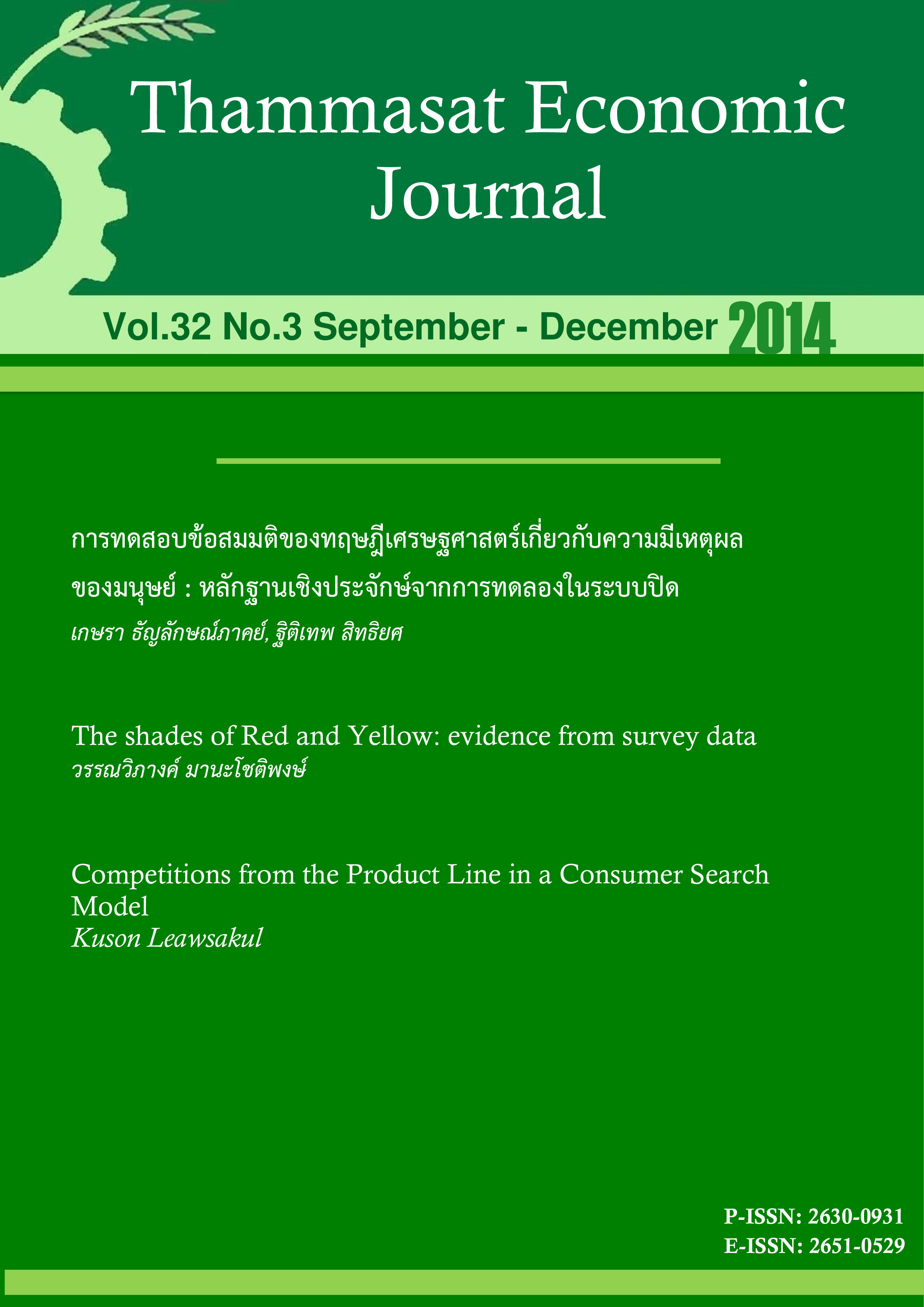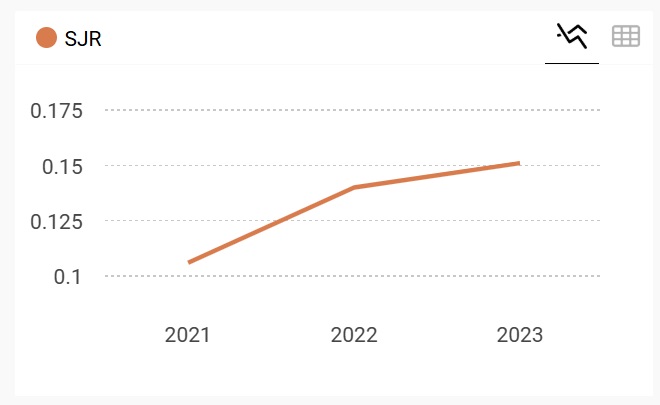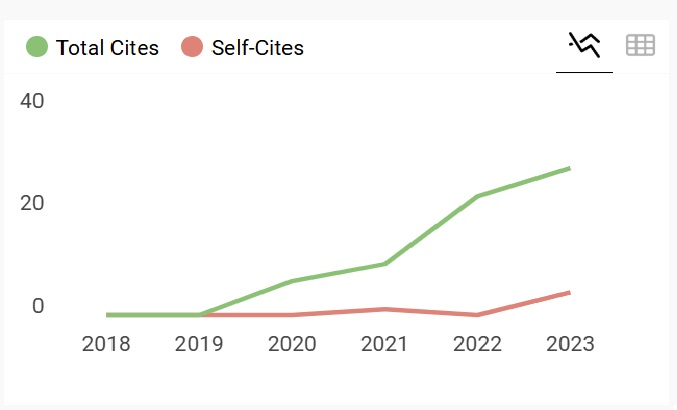The shades of Red and Yellow: evidence from survey data
Abstract
In Thailand, the political conflict during the past decade had led to a political polarization. This polarization is usually generalized as occuring between two groups: the red-shirt and the yellow-shirt. Despite such a practical depiction of the conflict, a conclusion should not be reached too hastily that the supporters of each color group simply share the same political attitudes and goals. Using survey data collected in 2012, this paper seeks to gain a better understanding of the variations in political attitudes within each group of political supporters. It also examines whether the red-shirt supporters and the yellow-shirt supporters are different in terms of their socioeconomic status and social preferences. The findings suggest that there are some variations in political attitudes and goals within each color group—there are at least 4 shades red-shirt and 3 shades of yellow-shirt. Results from an additional econometrics analysis suggest that the key determinants of political polarization in Thailand are occupation, education and social preferences. Income does not have a statistically significant impact once occupation, education, and social preferences are controlled for. However, because red-shirt supporters are likely to have unstable jobs and less education, they tend to have lower income. This political conflict is arguably a type of class conflict--the one between the volatile emerging middle class and the old middle class.
References
2.Berglund, Henrik. 2004. “Religion and Nationalism: Politics of BJP” Economic and Political Weekly 39(10): 1064-1070.
3.Favero, C.,Marcellino, M. and Francesca, N. 2005. “Principal Components at Work: The Empirical Analysis of Monetary Policy with Large DataSets” Journal of Applied Econometrics 20(5): 603-620.
4.Fuller, Dan A., Alston Richard M. and Vaughan, Michael B. 1995. “The Split between Political Parties on Economic Issues: A Survey of Republicans, Democrats, and Economists”. Eastern Economic Journal 21(2): 227-238.
5.Greene, William H. 2012. Econometrics Analysis. 7th ed., Upper Saddle River, NJ: Prentice Hall.
6.Jolliffe, Ian T. 2002. Principal Component Analysis, Series: Springer Series in Statistics, 2nd ed., New York: Springer.
7.Koo, Hagen. 1991. “Middle Classes, Democratization, and Class Formation: The Case of South Korea” Theory and Society 20(4): 485-509.
8.Kristov, L., Lindert, P. and McClelland, R. 1992.“Pressure Groups and Redistribution”.Journal of Public Economics 48(2): 135-163.
9.Maruyama, Geoffrey M. 1997. Basics of Structural Equation Modeling. London: SAGE Publications.
10.McFadden, Daniel L. 1977. "Quantitative methods for analyzing travel behaviour of individuals: Some recent developments".Working paper 474, Cowles Foundation.
11.---------------------. 1981. Econometric models of probabilistic choice. In Charles Manski and Daniel McFadden (eds). Structural Analysis of Discrete Data with Econometric Applications, pp, 198–272. Cambridge, MA: MIT Press.
12.--------------------. 1987, “Regression-based specification tests for the multinomial logit model” Journal of Econometrics 34: 63–82.
13.Prasad, M., Perrin, A., Bezila,K., Hoffman,S., Kindleberger,K., Manturuk,K., Powers,A.and Payton, A. 2009. “The Underserving Rich: “Moral values” and the White Working class”. Sociological Forum 24(2): 225-253.
14.Ross, George. 1978. "Marxism and the New Middle Classes: French Critiques," Theory and Society 5 (2): 163-190.
15.Rathbun, Brian C. 2007.“Hierarchy and Community at Home and Abroad: Evidence of a Common Structure of Domestic and Foreign Policy Beliefs in American Elites”. Journal of Conflict Resolution 51(3): 379-407.
16.Siamwalla, Ammar and Jitsuchon, Somchai. 2012. The Socio-Economic Bases of theRed/Yellow Divide: A Statistical Analysis. in Michael Montesano, Pavin Chachavalpongpun and Aekapal Chongvilaivan (eds). Bangkok May 2010: Perspectives on a Divided Thailand, pp, 64-71.
17.Singapore, Institute of Southeast Asian Studies (ISEAS) Publishing.
18.Sorens, J., Muedini, F. and Ruger W. 2008. “U. S. State and Local Public Policies in 2006: A New Database”. State Politics & Policy Quarterly 8(3): 309-326.
19.Train, Kenneth. 2003. Discrete Choice Methods with Simulation, Cambridge, MA: Cambridge University Press.
20.Weisberg, Herbert F. and Tanaka Aiji. 2001. “Change in the Spatial Dimensions of Party Conflict: The Case of Japan in the 1990s”.Political Behavior 23(1): 75-101.
21.Yamane, Taro. 1967. Statistics, An Introductory Analysis, 2nd ed., New York: Harper and Row.









